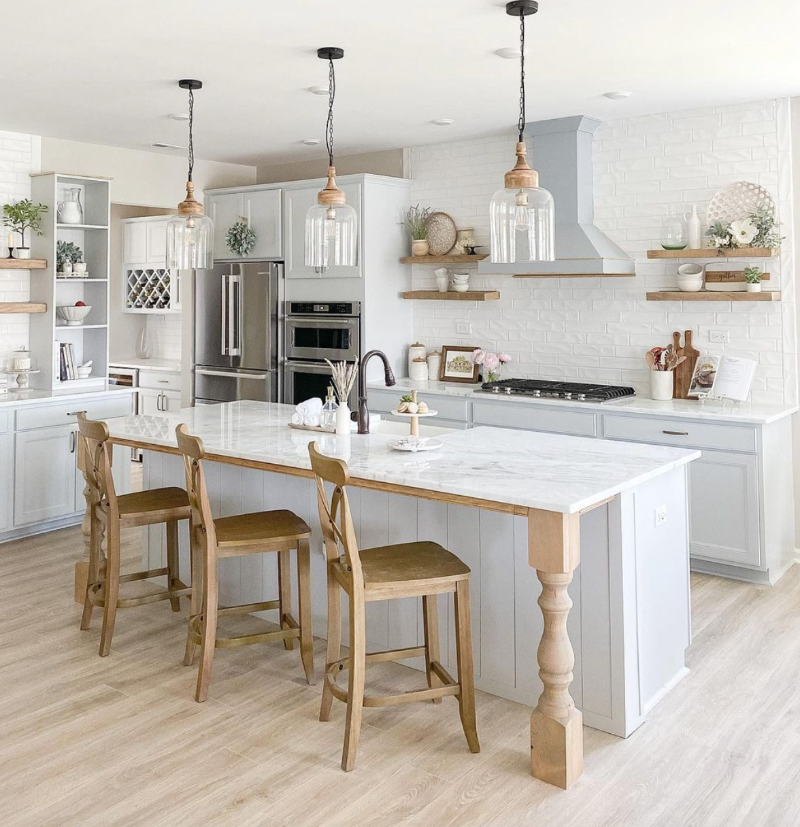The Relevance of a Sturdy Kitchen Island Leg in Creating a Practical Food Preparation Area
A sturdy kitchen island leg offers as an essential element in establishing a practical cooking environment, providing essential support for both the counter top and various kitchen tasks. As kitchen areas evolve into multifunctional areas for food preparation, dining, and socializing, the selection of materials and design factors to consider for island legs ends up being increasingly essential.
Advantages of Sturdy Island Legs
Providing important assistance, strong kitchen area island legs play a pivotal function in enhancing the capability and toughness of kitchen islands - kitchen island leg. These legs not just bear the weight of the countertop and any type of additional products put on the island, yet also add to the overall security of the structure. A well-supported kitchen area island ensures that it continues to be upright and functional, even under hefty usage, which is especially essential in hectic cooking area atmospheres
Moreover, tough island legs can enhance the visual charm of the kitchen area. They give a solid framework that can enhance various style styles, from modern to standard. This flexibility enables homeowners to personalize their cooking area islands according to individual taste while making sure that the architectural integrity stays uncompromised.
In enhancement to their encouraging role, robust kitchen area island legs can additionally boost safety. A steady island minimizes the risk of accidents triggered by tipping or tottering, which is specifically critical in houses with kids or senior people. Additionally, solid legs can help with a smooth circulation of tasks, permitting for reliable dish prep work and social interactions within the kitchen area area. Inevitably, buying sturdy kitchen island legs is essential for a functional and visually pleasing cooking location.
Products for Cooking Area Island Legs
When choosing materials for kitchen island legs, longevity and visual appeal are essential aspects to consider. The most usual materials include wood, steel, and crafted wood, each offering unique advantages.
Hardwood, such as maple, oak, or cherry, is a timeless selection because of its strength and ageless beauty (kitchen island leg). It can hold up against considerable weight and is resistant to put on, making it suitable for high-use kitchen settings. Additionally, wood can be stained or painted to complement different cooking area styles
Steel legs, typically crafted from stainless-steel or functioned iron, offer a commercial and modern-day look. They are incredibly solid and can support substantial tons while being immune to moisture and heat, which is useful in a cooking area. Steel legs can additionally be easily cleaned up, boosting their functionality.

Style Considerations for Stability
The choice of materials for kitchen area island legs directly affects the design factors to consider for stability. When designing a cooking area island, it is critical to review the weight-bearing capability of the picked materials. Larger materials, more info here such as strong wood or metal, generally supply greater security, especially under the tension of daily use.
Furthermore, the leg style should include proper geometry to improve security. A larger base boosts the support location, reducing the danger of wobbling or tipping. Factor to consider should also be offered to the height of the legs; out of proportion leg sizes can lead to discrepancy, endangering the general security of the island.
Moreover, the distribution of weight across the island is critical. Guaranteeing that the leg placement lines up with the heaviest parts, such as home appliances and kitchen counters, will certainly further enhance stability.
Maintenance Tips for Durability

Cleansing is an additional important facet of upkeep. Depending on the material of the legs-- whether timber, steel, or composite-- appropriate cleaning techniques must be used. For wooden legs, a mild clean with an appropriate timber and a wet cloth cleaner will assist protect their coating. Steel legs might call for a light gloss to avoid rust and preserve their radiance.
Furthermore, tightening bolts and screws regularly can ensure stability and prevent wobbling. Take into consideration strengthening the legs with added brackets or sustains to boost longevity if the cooking area island experiences hefty usage. Lastly, applying a safety surface or sealant can safeguard versus dampness and stains, lengthening the life-span of the legs. By adhering to these upkeep suggestions, homeowners can ensure their cooking see here now area island legs stay robust and functional for several years ahead.
Selecting the Right Leg Style
Routine upkeep makes certain that cooking area island legs continue to be tough and useful, but picking the right leg design is equally important for both aesthetics and support. The choice of leg design can dramatically affect the total style and consistency of your kitchen area.

Capability is another important facet. Thicker legs or those with a tough base can sustain larger kitchen counters and tools, enhancing the island's utility. On the other hand, slim legs might create an airy look, appropriate for lighter layouts yet potentially less encouraging.
Final Thought
In recap, the importance of sturdy cooking area island legs can not be overstated in the creation of a practical cooking location. These legs offer important assistance, improve security, and contribute to the total visual of the kitchen.
A sturdy kitchen island leg offers as a basic part in developing a practical food preparation atmosphere, providing essential assistance for both the counter top and various kitchen area activities.Providing crucial support, tough kitchen island legs play an essential role in improving the performance and resilience of cooking area islands. Eventually, spending in durable kitchen area island legs is vital for a useful and visually pleasing cooking location.
Factor to consider ought to likewise be offered to the height of the legs; disproportionate leg lengths can lead to discrepancy, endangering the overall stability of the island.
Wood legs give heat and a classic look, while metal legs supply a modern and industrial feeling.
Comments on “The Top Kitchen Island Leg Styles to Enhance Any Kind Of Style Aesthetic”